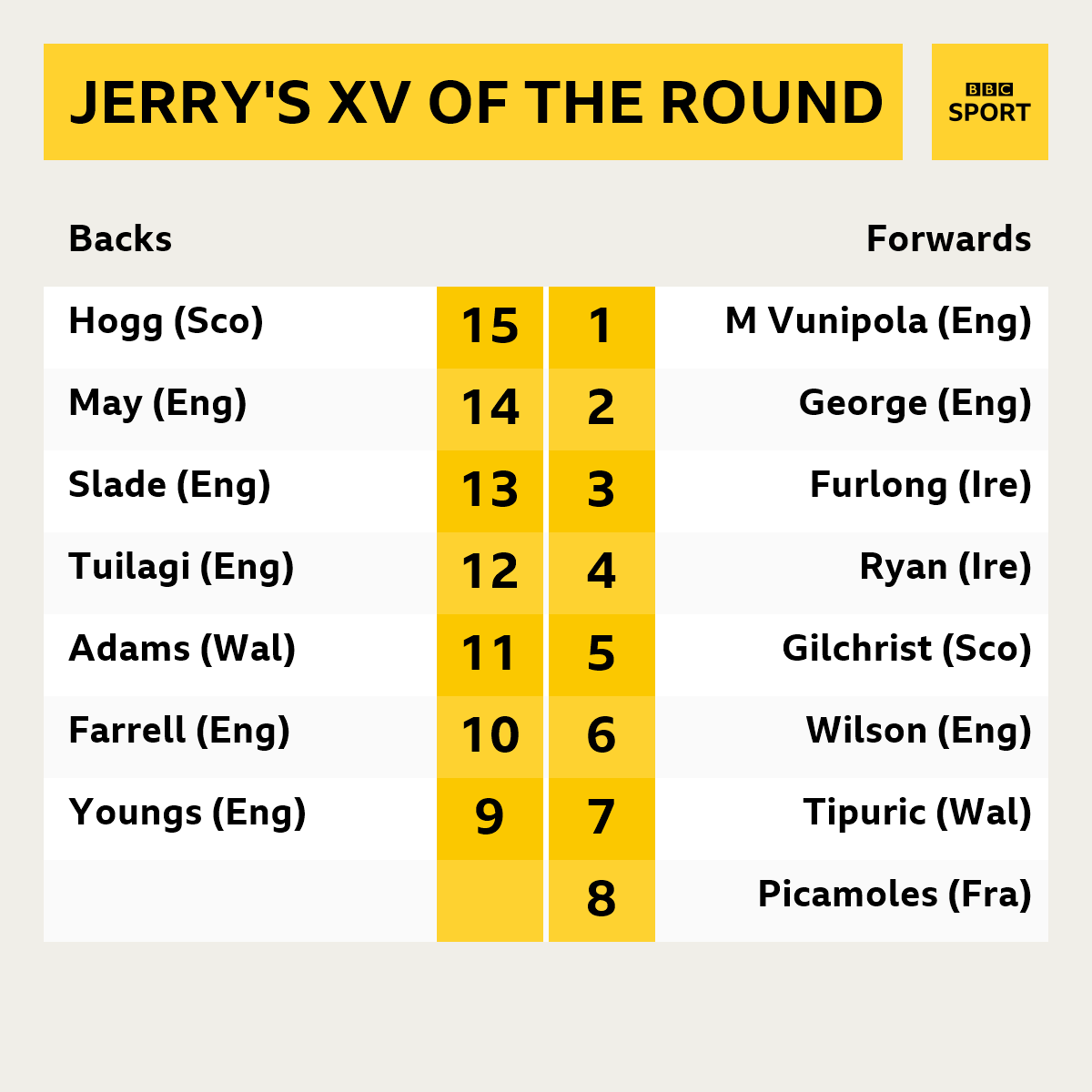Six Nations: England set tone with immaculate start against Ireland - Jeremy Guscott
- Published
- comments
Six Nations: England beat Grand Slam champions Ireland 32-20
After all the hype, expectation and predictions, it only took 91 seconds for England to show everything that was to follow in their superb performance against Ireland.
As a statement of intent, it was emphatic.
They unsettled Ireland, denied them any opportunity to stifle play and were clinical in using space.
Let's take a closer look.
0:35
Whatever chaos unfolds in a Test match, there are certain aspects that can be predicted - like the opening exchanges in a chess match.
By kicking off deep and making sure his chasers are applying pressure, England captain Owen Farrell knew that Ireland would most likely catch, set a platform and clear their lines, probably conceding a line-out in their half.
That is exactly what happened.
The ploy England pulled next was much harder to predict. Jamie George got the ball in his hands so quickly that the television cameras were caught out as the England hooker slung the ball over the back of the line-out to centre Manu Tuilagi coming onto the ball at pace.

As Ireland lined up for the line-out, England played it coy, slow to reveal how many men they were committing to the set-piece

Billy Vunipola, playing as stand-in scrum-half, bolts for the back of the line to provide support for Tuilagi
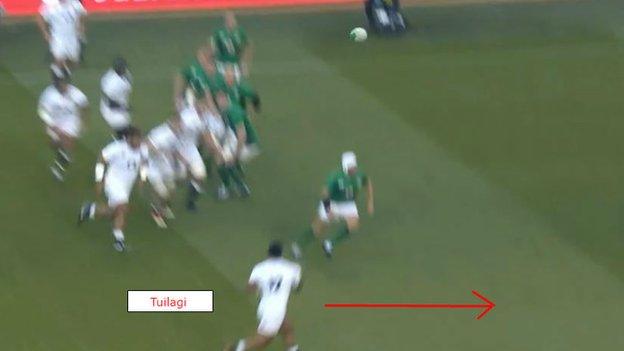
Tuilagi meets the ball at pace and unopposed...
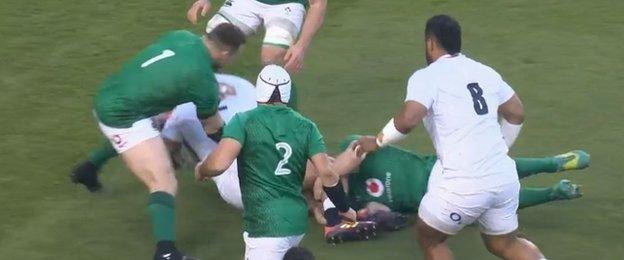
...and has Billy Vunipola for company as he runs into Josh van der Flier
It is an ambitious move to attempt.
It denied George the easy 'loosener' options that hookers often call in their opening line-out in a big game. The Saracen had to keep his throw straight over a much longer distance than usual, while Tuilagi had to time his run precisely to hit the ball at pace, while avoiding straying offside.
It worked though, bringing England's midfield bludgeon into the game at the first opportunity and showing the innovative, accurate attacking rugby they were determined to play in the Ireland half.
0:45
England's second phase was another pre-planned play as Owen Farrell broke blind and Jonny May came in off his wing to take an inside ball at pace.

Under the cover of Sinckler and Mako Vunipola's decoy runs, Owen Farrell breaks blind...

...taking the ball off Youngs and triggering May's inside line
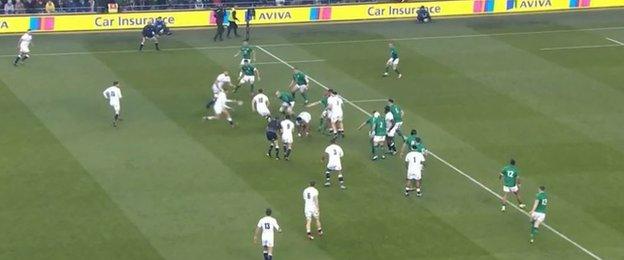
May takes the ball at speed and, picking a hole in the Ireland defence, makes it to the Ireland 22m
Given all the talk of England's physically-imposing team selection, Ireland's strictly-organised defence might have expected a brutal, but straightforward, confrontation.
Instead they were suddenly being presented with unorthodox patterns and challenges they wouldn't have prepared for.
00:51
Each phase is a sliding doors moment. If it doesn't come off and England are knocked back behind the gainline, momentum is lost and the attack stalls. But while they keep making yards and providing the forwards with a target, the pressure accumulates.
It is Kyle Sinckler's skillset that wins this particular battle for England. He steps inside CJ Stander's rush out of the defensive line and puts another dent in the Ireland defence.
Not all props have that ability, but he is nimble and explosive and England have won a third successive phase.
00:59
One half of the challenge coach Eddie Jones set England before kick-off was to win the battle on the floor.
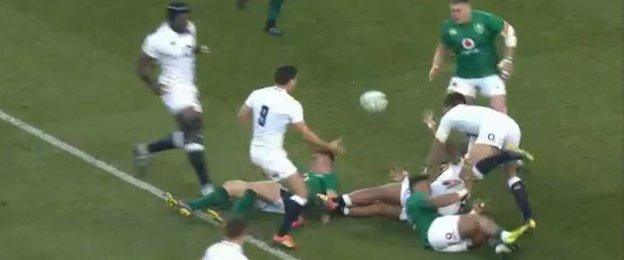
Tuilagi keeps the ball alive
Here Manu Tuilagi pops the ball up to scrum-half Ben Youngs. It keeps the tempo high, denies Ireland any chance to slow up possession and cuts down on the defence's time to organise.
01:02
From that quick ball, Tom Curry gets confrontational, steaming into the tackle.
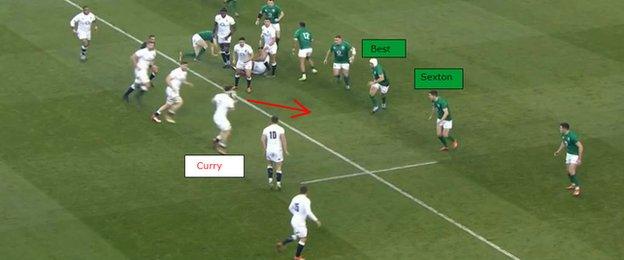
Curry hits an angle to engage Johnny Sexton, rather than Ireland captain Rory Best...
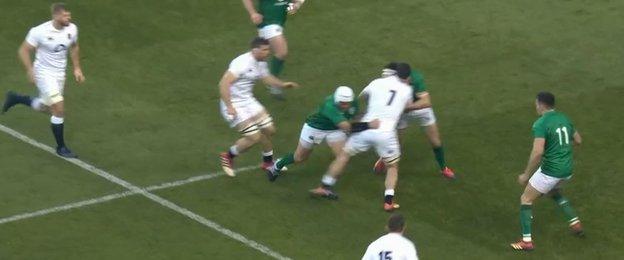
...ensuring he makes it over the gainline once again
That was the tone of the whole match and it was set in these opening exchanges.
Eddie Jones had asked his players to take on their opposite numbers and dominate them in the physical contest.
Curry - not the biggest ball-carrier in the team - is taking on the challenge to win that gladiatorial battle.
01:06
Kyle Sinckler shows a different way to win the collision once again, using his skills to find a gap between CJ Stander and James Ryan.
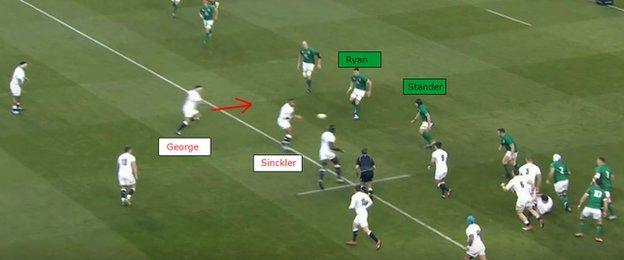
Sinckler dummies a pass to Jamie George on his shoulder...
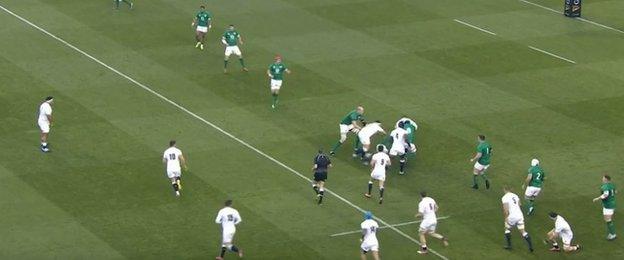
... and squirms his way deeper into the Ireland 22m
Ireland are having to reset, reshape and cannot get the coherent collective speed off the line.
01:12
This is the one point in England's opening salvo where they nearly ceded momentum.
Jack Nowell is too upright, taking the ball into a clutch of Ireland's forwards and is nearly held up. It is a mistake.
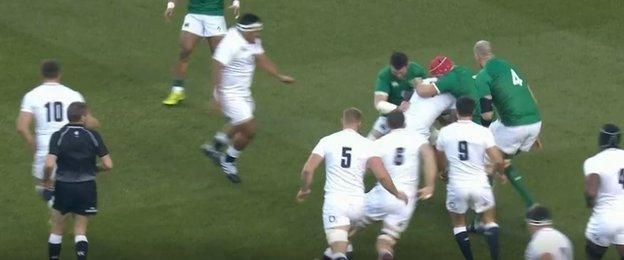
Jack Nowell runs into Josh van der Flier and Peter O'Mahony...

...but Mako Vunipola and Mark Wilson prevent Ireland holding him up in the choke tackle
But he manages to wrestle his way to the ground with the help of Mark Wilson and Mako Vunipola.
Ireland are renowned for their jackaling ability (getting over the ball in the ruck) but, in these phases, and the match overall, England brought enough support around the ball carrier to win the collision, clear out, and prevent Ireland getting a sniff of a contest.
01:21
England bring in another of their heavy ball-carriers as Billy Vunipola is asked to batter over the gainline.
He had a big game, carrying for 23 metres, more than any other forward, as England's physicality wore down Ireland.
On this occasion he is being hustled back. However, like Tuilagi, he manages to get the offload away to Youngs.
01:26
Vunipola's pass actually catches England more by surprise than Ireland. Owen Farrell is still organising the men outside him as Vunipola releases.
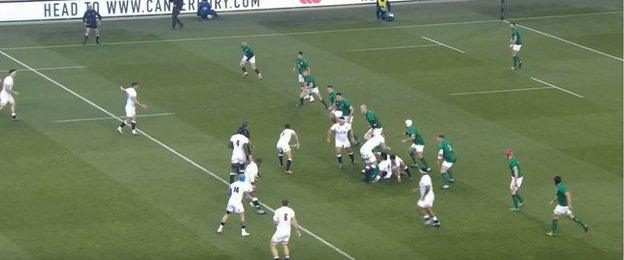
Farrell (with his arms outstretched) was still organising his backline as Youngs passed to him
Ireland were off their mark smartly but, while Conor Murray realises they are short of numbers and need to stay flat, drift and use the touchline, Earls hares up to try and get in the face of Tuilagi.
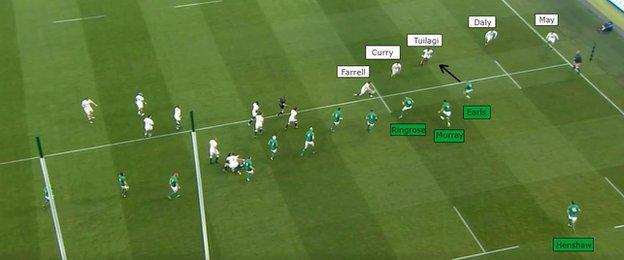
Earls' eagerness to get out to Tuilagi creates a dogleg in the Ireland defence
It is a Hail Mary play from Earls that demonstrates what Tuilagi's presence can do to an opposing defence, even when he doesn't get the ball. The threat he carries can cause defences to get out of shape in their eagerness to minimise his yards.
When England beat New Zealand in 2012 you saw the same thing when, with England just a point ahead in the second half, Conrad Smith drifted needlessly across to Tuilagi, allowing Brad Barritt to ghost through a gap and, ultimately, score. You can see the incident 57 seconds into the video below.
England 38-21 New Zealand highlights
From my playing days, I know how useful it is to have that sort of handful of a player inside you - the likes of Simon Halliday, Will Carling and Scott Gibbs - who take a lot of stopping and create holes on either shoulder for an outside centre to exploit.
It may have looked like a high-wire, risky decision for Farrell to throw that pass, but it will have been too instinctive for him to have had any concerns.
He will have had a feel for the shape of the defence and the width of the channel he had to get the ball through, and understood he could make it.
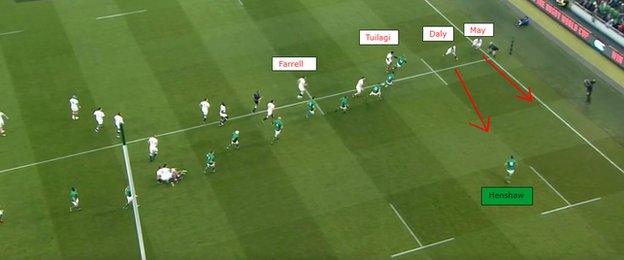
Farrell's pass released Elliot Daly and Jonny May down the left wing
Having that sort of brain is so powerful on the pitch, it creates space more effectively than even the quickest player.
01:31
The two-on-one, like most of the chances that came England's way, was expertly finished.
Elliot Daly hits the ball at pace and tracks infield slightly to fix full-back Robbie Henshaw and open up space on his outside for Jonny May.
Even in the final act you can see the fine margins. Daly's pass to May is not very sympathetic, and the wing needs two bites of the cherry to control it and take it in.
Eddie Jones' decision to pick Daly over Mike Brown at full-back was one of the contentious pre-match calls by the England coach, but it was totally vindicated.
May's superb display, gobbling up the barrage of right-foot kicks that Conor Murray rained down on England's left wing, ensured England won their aerial battle.
Daly was solid under the high ball, and he is also a more accomplished attacker than Brown, as he showed with his clever grubber kick for England's second try.
Six Nations Shuffle: Howlers, hat-tricks, freezing temperatures & epic comebacks
Ireland's regret
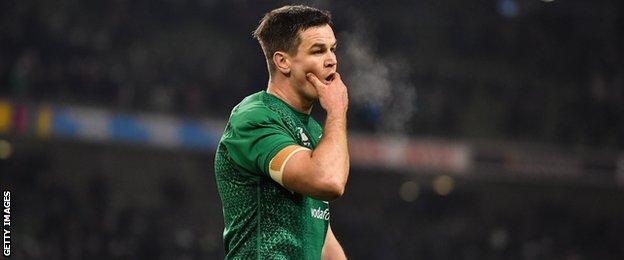
Ireland had won their last 12 home games in all competitions
For the most part, Ireland were starved of decent attacking platforms as England played low-risk, smart, clean rugby in their own half.
According to analytics company Gracenote, Ireland had the ball in the England 22m just three times in the whole match - their lowest total in the 18 months it has been collecting that statistic. , external
Ireland came away with points on each occasion, but just could not get in range often enough to sway the scoreline.
The obvious route back into the game was when England were reduced to 14 men by Curry's yellow card in the 12th minute.
When Ireland beat New Zealand in Chicago in 2016, Joe Schmidt's side scored two tries while the All Black prop Joe Moody was in the sin-bin.
But a succession of handling errors and poor decisions prevented them doing similar against England.
Five minutes after Curry was shown yellow, Itoje could have joined him in the sin-bin for his aerial challenge on Keith Earls. It could easily have been another yellow card and England down to 13 men, but referee Jerome Garces decided otherwise.
England dominance | ||
|---|---|---|
Ireland | England | |
8 | Dominant tackles | 48 |
3 | Turnover tackles | 5 |
14 | Turnovers conceded | 11 |
Of greater interest to Schmidt in his team's video debrief will be what happened in the 63rd minute.
With Ireland trailing 17-13, a well-judged box-kick from Murray was tapped back to Irish hands by Henshaw.
England's defence was narrow, Ireland had men over, but Garry Ringrose, distracted by Tuilagi's Earls-esque rush out of defence, opts not to give the pass to Sexton.

Garry Ringrose had options with Van der Flier running a strong line and Sexton hanging back
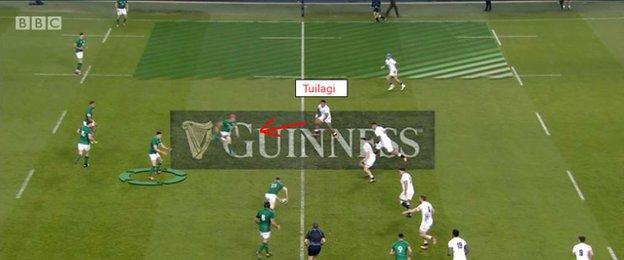
With Sexton calling for the ball and space out wide to be exploited Tuilagi comes up out of the defensive line
Instead he ploughed into contact and knocked on.
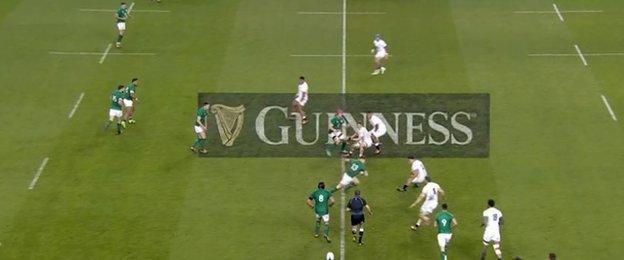
Ringrose hangs on to the ball...
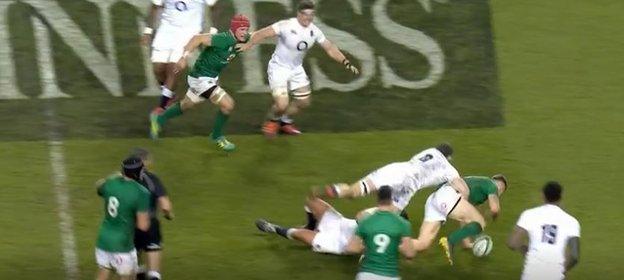
...and loses it in contact
Had the ball gone wide, Ireland were going to make big gains and probably dent, if not wipe out, England's lead.
Instead, from the resulting scrum, England spun wide, May kicked ahead and Slade dotted down for a try that put the visitors nine points clear and out of reach.
